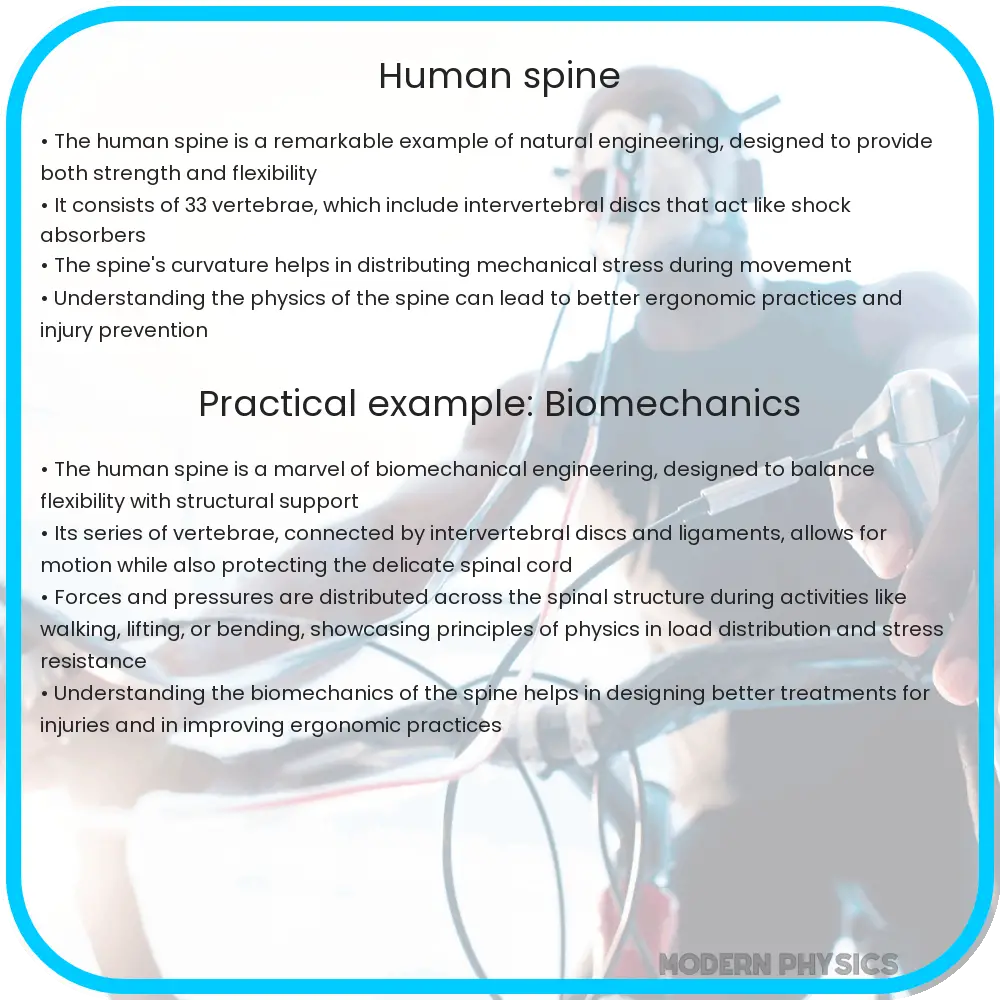Explore the biomechanics of the human spine, covering statics, support, posture, movement analysis, and the impact of external forces on spinal health.

Understanding the Biomechanics of the Human Spine
The human spine is a marvel of biomechanical engineering, playing a critical role in our daily activities. Its primary functions include providing structural support, enabling flexible motion, and protecting the spinal cord. The spine’s complex structure and function can be analyzed through various aspects of biomechanics, such as statics, support, and posture.
Statics and Support of the Spine
Statics in biomechanics refers to the study of bodies in a state of equilibrium. The human spine, when viewed through this lens, is a structure that maintains balance and support under the influence of gravitational forces. It comprises vertebrae, intervertebral discs, ligaments, and muscles, each contributing to its overall stability.
The vertebrae, stacked on top of each other, form the vertebral column. This arrangement provides structural support and protects the spinal cord. The intervertebral discs, located between each vertebra, act as shock absorbers. They are composed of a tough outer layer, the annulus fibrosus, and a gel-like center, the nucleus pulposus, which helps distribute compressive forces evenly.
Spinal Curvature and Posture
An essential aspect of spine biomechanics is its natural curvature. The human spine exhibits four main curves: cervical, thoracic, lumbar, and sacral. These curves enhance the spine’s strength, flexibility, and ability to absorb shock. Proper alignment of these curves is crucial for maintaining good posture, which in turn reduces the risk of spinal injuries and back pain.
Posture analysis involves examining the alignment of the spine and its effect on the body’s overall biomechanics. Poor posture can lead to an uneven distribution of forces across the spine, causing strain and potential injury. For instance, prolonged sitting with a slouched back can increase pressure on the lumbar discs, leading to discomfort and degenerative changes over time.
Muscles play a vital role in maintaining spinal posture. The erector spinae, a group of muscles running along the spine, helps maintain an upright posture and supports the spine during bending and twisting movements. Strengthening these muscles is often a key component in improving spinal health and posture.
In conclusion, understanding the biomechanics of the human spine is crucial for appreciating its role in our daily lives. The intricate balance of statics, support, and posture not only highlights the spine’s complexity but also underscores the importance of maintaining spinal health for overall well-being.
Biomechanical Analysis of Spinal Movements
The biomechanics of the spine also encompasses the analysis of spinal movements. These movements include flexion, extension, lateral bending, and rotation. Each movement involves a specific set of muscles and joints, contributing to the spine’s dynamic functionality. For example, flexion (bending forward) and extension (bending backward) primarily occur in the lumbar region, involving the interplay of both vertebral joints and supporting muscle groups.
Impact of External Forces on Spinal Biomechanics
External forces, such as those experienced during lifting or carrying, significantly impact spinal biomechanics. The spine’s ability to distribute these forces is vital to prevent injury. When lifting an object, for instance, proper technique involves using the legs to bear most of the weight, thus reducing the load on the lumbar spine. Failure to do so can lead to increased pressure on the discs and vertebrae, potentially causing injuries like herniated discs or muscle strains.
Role of Spinal Biomechanics in Clinical Applications
In clinical settings, the principles of spinal biomechanics are applied in diagnosing and treating spinal disorders. Conditions such as scoliosis (a lateral curvature of the spine), kyphosis (excessive outward curvature), and lordosis (excessive inward curvature) are analyzed through biomechanical models to determine the best course of treatment. Additionally, biomechanical considerations are crucial in the design of spinal surgeries, prosthetics, and rehabilitation programs.
Technological Advancements in Spinal Biomechanics
Recent technological advancements have significantly enhanced our understanding of spinal biomechanics. Tools like computer modeling, 3D imaging, and motion capture systems allow for more precise analysis of spinal movements and forces. These technologies have not only improved diagnostic capabilities but have also aided in the development of more effective treatment strategies and ergonomic solutions.
Conclusion
In summary, the biomechanics of the human spine is a field that combines principles of mechanics, biology, and physics to understand the spine’s structure and function. This understanding is crucial for the prevention and treatment of spinal disorders and injuries. The spine’s ability to provide support, withstand forces, and facilitate movement highlights its intricate design and importance in the human body. As research and technology continue to advance, our comprehension and ability to care for this vital part of the human anatomy will only improve, leading to better health outcomes and quality of life.
